When your brake fluid cap goes missing, you’re facing immediate safety risks that can lead to brake failure. The exposed reservoir allows moisture, dirt, and air to contaminate your brake fluid, causing spongy pedals and reduced stopping power. You’ll need to temporarily cover the opening with plastic wrap secured by a rubber band until you can install a proper replacement cap. After replacing the cap, inspect your brake fluid for contamination signs and consider flushing the system if the fluid appears dark or cloudy, as thorough maintenance steps will guarantee your braking system remains reliable and safe.
Quick Tips
- Missing brake fluid cap allows contamination, moisture, and air to enter the system, causing brake failure and reduced stopping power.
- Contaminated brake fluid creates spongy pedals, longer stopping distances, and potential complete brake system failure during emergencies.
- Temporarily cover the reservoir opening with plastic wrap and rubber band until obtaining a proper replacement cap.
- Replace the cap immediately, check fluid quality for contamination, and bleed brakes to remove air bubbles from the system.
- Prevent future issues by regularly inspecting the brake fluid reservoir and ensuring the cap remains securely fastened.
What Happens When Your Brake Fluid Cap Goes Missing
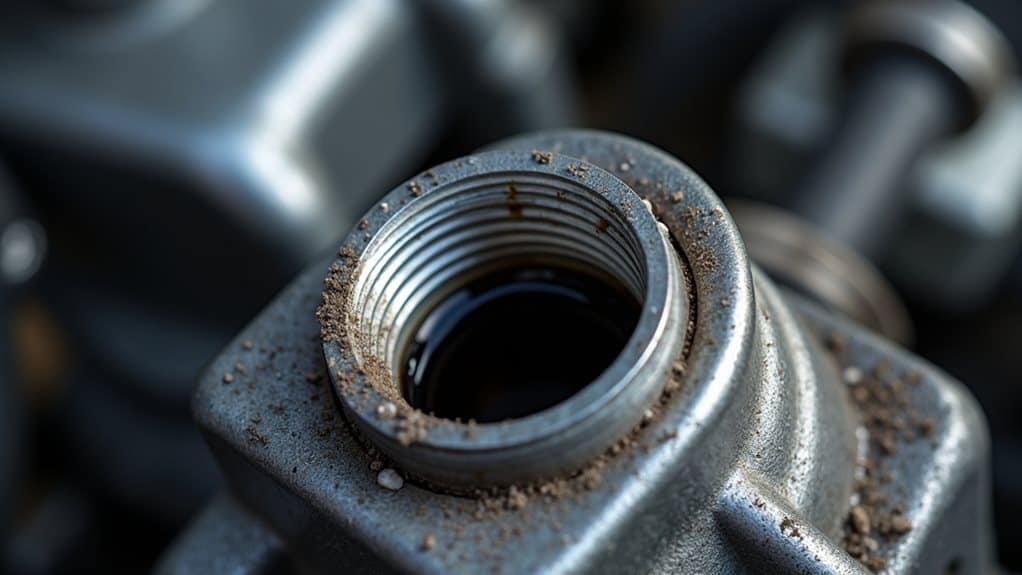
When your brake fluid cap goes missing, the sealed environment that protects your brake system’s hydraulic fluid becomes compromised, exposing this critical component to several immediate and long-term risks.
You’ll face contamination from dirt and debris, moisture absorption that degrades fluid quality, air ingress causing spongy brakes, and evaporation that lowers fluid levels below safe operating minimums. However, brake lines themselves typically remain structurally sound and don’t suffer rapid damage from a missing cap exposure. Driving without adequate brake fluid can lead to total brake failure, which poses significant safety risks while operating the vehicle.
Immediate Safety Risks of Driving Without a Brake Fluid Cap
While your vehicle might seem to operate normally at first, driving without a brake fluid cap creates several immediate safety hazards that can escalate quickly from minor inconvenience to life-threatening brake failure.
You’ll face fluid leakage, moisture contamination, and air ingress that compromises hydraulic pressure. This results in soft pedals, reduced stopping power, and potentially catastrophic brake system failure. Additionally, bleeding brakes is essential to ensure that any air that has entered the system is effectively removed, maintaining optimal braking performance.
Moisture contamination can degrade rubber seals in the braking system, leading to further deterioration of brake components over time.
How Contamination Affects Your Brake System Performance
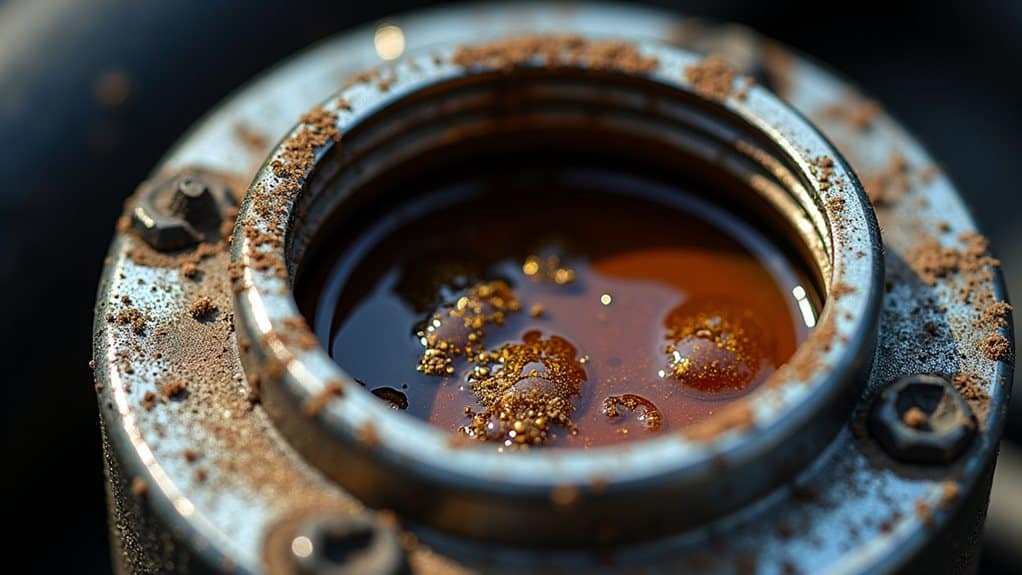
When your brake fluid cap goes missing, contaminants immediately begin infiltrating your brake system, creating multiple pathways for performance degradation.
Dirt particles and debris will obstruct fluid flow through your brake lines, reducing the system’s responsiveness when you press the pedal.
Meanwhile, moisture from the air gets absorbed into the hygroscopic brake fluid, which lowers its boiling point and can cause vapor formation that makes your brakes feel spongy and less effective. Additionally, clogged brake lines can further exacerbate the issue, leading to inadequate brake performance and safety hazards.
Dirt and Debris Effects
Contamination poses one of the most serious threats to your brake system’s performance and safety.
When dirt and debris enter through a missing cap, particles clog narrow brake lines, reducing hydraulic pressure transmission. This creates inconsistent brake pad engagement, increased stopping distances, and irregular pedal feel.
Abrasive contaminants damage seals and cylinders, causing leaks and potential brake failure.
Moisture Absorption Consequences
Beyond the immediate damage from solid particles, brake fluid faces an even more insidious threat through moisture absorption.
Your brake fluid can absorb 2% moisture within twelve months, causing a 25% drop in boiling point with just 3% contamination.
This creates vapor bubbles under heat, making your brake pedal feel spongy and reducing stopping power considerably.
Moisture Absorption and Its Impact on Brake Fluid Effectiveness
Although brake fluid appears to be a sealed system, it naturally absorbs moisture from the environment through a process called hygroscopic absorption.
This moisture enters through microscopic pores in hoses, seals, and connection points.
Within twelve months, your brake system can absorb up to 2% moisture by volume, markedly reducing fluid effectiveness and compromising safety. Regular monitoring of oil pressure levels is essential to prevent significant issues in other vehicle systems, including the brake system.
Emergency Temporary Solutions to Protect Your Brake Reservoir
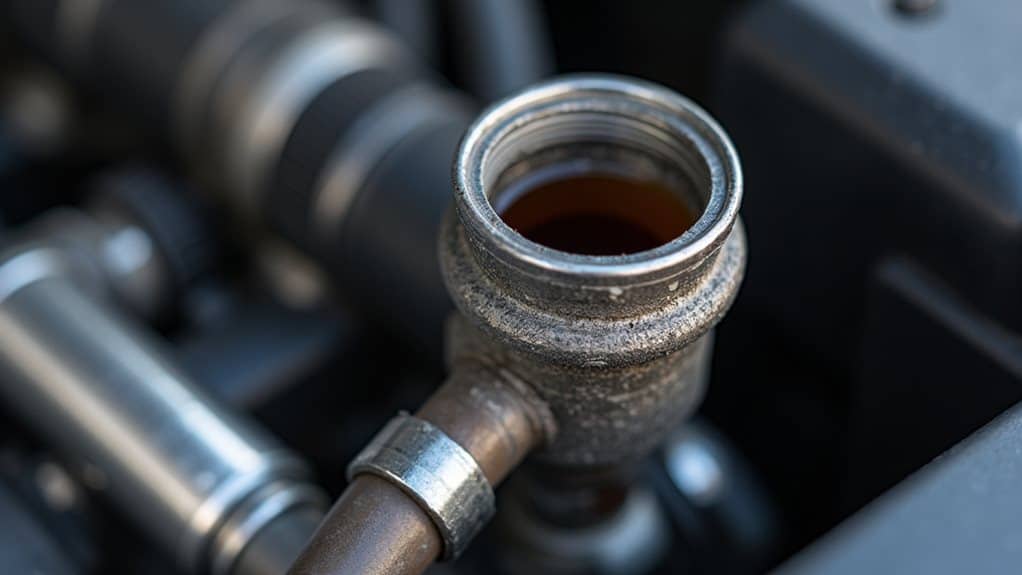
When your brake fluid cap goes missing, you’ll need to act quickly to protect the reservoir from contamination while you source a proper replacement.
Tightly wrap clean plastic film over the opening, securing it with a rubber band. Alternatively, use a small plastic bottle cap that fits snugly.
These temporary solutions prevent moisture and debris infiltration until you obtain the correct cap.
Where to Find Replacement Brake Fluid Caps
You’ll find replacement brake fluid caps through several reliable sources, with authorized dealerships and local auto parts stores being your most accessible options.
Dealerships stock OEM (Original Equipment Manufacturer) caps that guarantee proper fit and compatibility with your vehicle’s brake system, though you might face longer wait times if the part isn’t immediately available.
Auto parts retailers like AutoZone, O’Reilly, and NAPA carry universal caps that fit multiple vehicle models, offering a quicker solution when you need immediate access to replacement parts.
Dealership and Parts Stores
Finding a replacement brake fluid cap requires knowing where to look, and two primary sources stand out for their reliability and accessibility: authorized dealerships and auto parts stores.
Dealerships offer OEM caps with precise fit and warranty coverage, while parts stores like NAPA and Advance Auto Parts provide immediate availability with varied price points and aftermarket options.
Online Sourcing Options
Beyond traditional brick-and-mortar locations, the internet opens up a vast network of sourcing options that can help you locate the exact brake fluid cap your vehicle needs.
Specialized retailers like JDC Customs offer premium titanium caps with universal fitment across hundreds of models.
Large marketplaces such as Walmart provide extensive selections with user reviews and competitive pricing for informed purchasing decisions.
Step-by-Step Guide to Installing a New Brake Fluid Cap
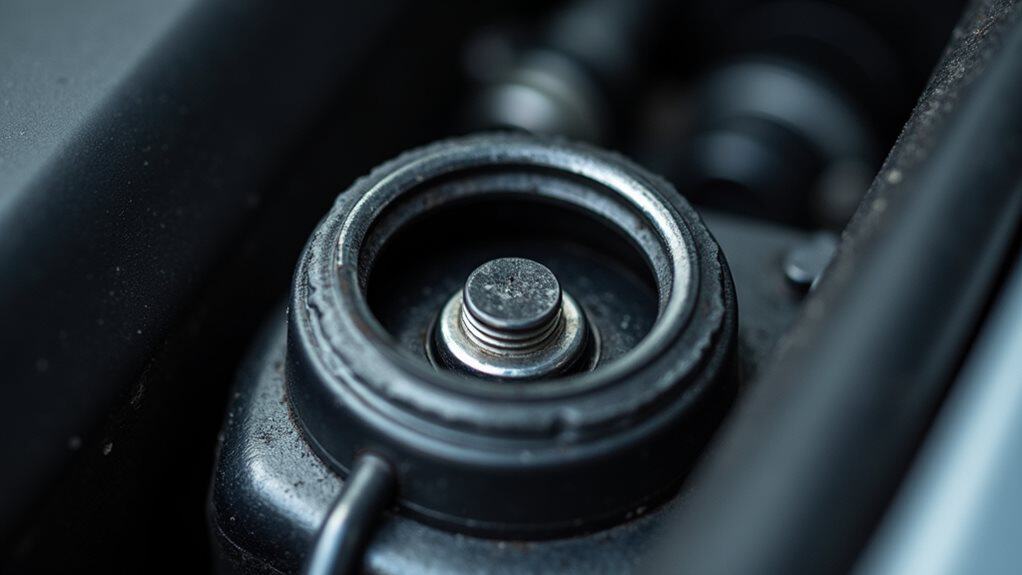
Once you’ve acquired the correct replacement brake fluid cap, installing it properly requires careful attention to detail and adherence to specific safety procedures.
First, park on level ground with the engine off and parking brake engaged. Clean the reservoir opening thoroughly, removing any debris or fluid residue.
Align the new cap carefully, ensuring proper seating before securing fasteners.
Essential Brake System Inspection After Cap Replacement
After you’ve successfully installed a new brake fluid cap, you’ll need to conduct a thorough inspection of your entire brake system to guarantee everything functions safely and properly.
Start by checking the quality of your brake fluid, looking for signs of contamination like dark coloration, debris, or water that might’ve entered the system while the cap was missing.
Next, you’ll want to test your brake performance through careful driving tests, paying close attention to pedal feel, responsiveness, and any unusual sounds that could indicate system problems.
Fluid Quality Assessment
The brake fluid’s quality becomes your primary concern when replacing a missing cap, as exposure to atmospheric moisture can rapidly degrade this critical hydraulic component.
You’ll need to assess moisture content, which typically increases 1-2% annually and lowers boiling points dangerously.
Check fluid color and clarity for contamination signs, then test using refractometers or conductivity pens for accurate readings.
Brake Performance Testing
When you’ve replaced a missing brake fluid cap, thorough brake performance testing becomes essential to verify your vehicle’s braking system operates safely and effectively.
First, bleed the brakes to eliminate air bubbles, then check fluid levels and pedal firmness.
Test brake balance, effort, and response during application.
Monitor for unusual noises, vibrations, or mechanical irregularities.
When to Flush and Replace Contaminated Brake Fluid
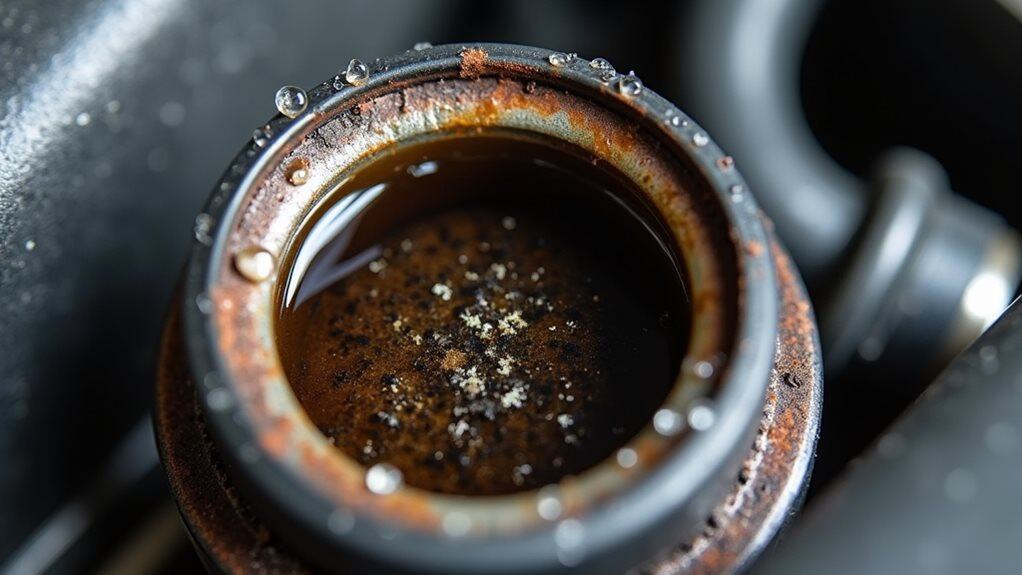
Since brake fluid contamination poses serious safety risks to your vehicle’s stopping ability, recognizing when to flush and replace the fluid becomes essential for maintaining proper braking performance.
You’ll need immediate replacement if you notice darkened fluid, spongy pedal feel, or visible leaks.
Don’t wait—flush the system immediately after uncovering a missing cap, as environmental exposure creates contamination that compromises braking efficiency.
Preventing Future Brake Fluid Cap Loss and Maintenance Tips
Beyond addressing contaminated brake fluid, establishing a thorough prevention strategy will protect your brake system from future cap-related problems and maintain peak efficiency.
Conduct frequent visual inspections of your brake fluid reservoir, ensuring the cap remains securely fastened.
Replace worn caps immediately with OEM components, and incorporate cap checks into regular maintenance routines for ideal safety.
Wrapping Up
Don’t delay replacing your missing brake fluid cap, as contamination compromises your vehicle’s stopping power. You’ve learned that moisture and debris infiltration can cause brake failure, making immediate action crucial. Install a proper replacement cap, inspect your brake system thoroughly, and flush contaminated fluid when necessary. Regular maintenance checks prevent future cap loss and guarantee ideal brake performance. Your safety depends on maintaining a sealed, clean brake fluid reservoir system.

